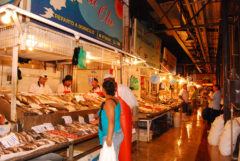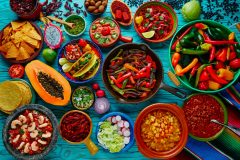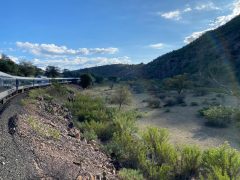Central America’s Road Less Travelled

Slender green tendrils reach out from the tropical rainforest like the fingers of a trusting child. But behind these delicate creepers squats the vast animal presence of a dense, steaming jungle: a thick, musky thousand-square-kilometre pelt of mahogany, broad-leafed banana palms and vast shivering ferns that stretches in all directions to the horizon.
Here it rises, morphing into ghostly cloud-forest as it climbs, and then thick pine, before finally emerging as the glorious, mist-crowned summit of Pico Bonito: Honduras's third-highest peak, and part of the sweeping Nombre de Dios (‘Name of God’) mountain range.
"It's 2,500 vertical metres of habitat," said James Adams, with something like paternal pride. "Each level supports its own ecosystem."
As manager of the elegant Pico Bonito Lodge, a collection of secluded, luxurious cabins set in the heart of the fiercely protected national park of the same name, James is used to seeing guests slack-jawed with wonder. Not just at the sight of so much nature, but at the sound: cicadas rattle like a mariachi band, toucans croak and the boom of howler monkeys erupts from deep in the jungle. Iridescent green and blue hummingbirds dive shrieking into the hibiscus flowers like kamikaze fighter pilots.
Set in the heart of Central America, Honduras is as picturesquely rugged as it is boisterously lush. Dominated by soaring mountain ranges that channel some of Central America's major rivers, it offers a verdant habitat for more than 700 species of bird and 200 species of mammal, living in 80 protected wilderness areas and 20 vast national parks. It also boasts 644km of Caribbean coastline, with the idyllic Bay Islands offering easy access to the Mesoamerican barrier reef, the world's largest after Australia's. But despite its numerous attractions, Honduras is one of the least visited countries in Central America. By comparison, Costa Rica – less than half the size – receives more than twice as many visitors.
According to my guide, Walter Villamil, it's because Honduras has done a poor job of promoting itself. "Honduras lacks a theme," he explained philosophically. "Guatemala has La Ruta Maya; Costa Rica has its eco-attractions. Honduras has all that – history, nature, culture. We have ethnic groups and colonial towns, too. But tourists don't know about it, so they don't come."
One attraction that does seem to have made it on to the tourist map is Copán, the archaeological site whose Mayan ruins, dating from between the fifth and ninth centuries, are scattered over 24sq km of jungle.
Eight o'clock in the morning and the heat was already pitiless as Walter and I picked a path between bulging roots and lumps of stone into the dense jungle that had engulfed Copán until the 19th century. It was madly atmospheric: overhead, huge red and blue macaws streaked noisily across the forest canopy like fireworks. They settled in the giant ceiba trees that were sacred to the Mayans, who believed that their branches, trunk and roots embodied the heavens, earth and hell. The Mayans were fond of symbols and legend. They also knew how to make an impression. I stumbled from the jungle and found myself in the arresting west (or ‘death’) court, a broad, open plaza featuring the first of a series of huge pyramids. A sprawling collection of altars, stelae and monuments were scattered around, their intricate carvings recounting the battles and beliefs of a people accomplished in the arts of engineering, astronomy and physics. Some say sniffily that Copán isn't as impressive as Tikal in Guatemala, but the quality and condition of Copán's artefacts is so good that they have informed much of what we know about Mayan civilisation today.
The majority of Honduras's tourists, many following the Ruta Maya, come from the US, flying into the small, efficiently run airports. Honduras has an excellent internal flight network, and it was an easy 30min hop out to Roatán, the biggest of the three Bay Islands.
The Bay Islands have an interesting history: although Honduras was part of the Spanish empire, the Bay Islands were mostly ruled by the British during the colonial period. They were also home to the original pirates of the Caribbean, with as many as 5,000 aquatic outlaws living on Roatán in the mid-17th century. Nowadays the major attraction is diving. The islands are on a fringing reef system, meaning the coral extends from the shoreline, so you can snorkel to it in minutes. And diving is cheap: you can get Padi-qualified from as little as £200.
"It's as good as the Red Sea here," declared Laura, a dive instructor from London. "Great visibility and really interesting reef life." Laura knew nothing about Honduras before she arrived, and now she's been living here for two years. "Roatán's like that," said Aleksandra Chemeris, a New Yorker and keen diver. "People come for three days, and stay for two months."
After kicking off my shoes and joining the crowd of margarita drinkers at a beach-bar shack in West End (the epicentre of Roatán's hostels and nightlife), I found it wasn't a stretch to see why.
In a quiet cove up the coast, Palmetto Bay Plantation is a boho-boutique lodge with high-end self-catering cabins hidden among the thatch of beachside palm trees. Blue crabs scuttled down sandy burrows with an indignant pop, and hot air rustled through heavy palm fronds like a sigh as I walked to the boardwalk to meet master diver Laurie Shrader and her captain, the insanely handsome Alberto. I was a scuba rookie, so Laurie spent the morning teaching me the basics, then I was ready for my first dive. Sailing to the dive site took all of one minute (the site isn't called One Minute West for nothing). Alberto helped me into my gear, and I followed Laurie, rolling backwards off the side of the boat into the Caribbean.
I stuck my masked face under the surface immediately – and there was the reef: 12 metres of crystal-clear water below. It was an astonishing Atlantis: tropical fish gliding around huge turrets and deep valleys of coral, colourful sponges and grass beds undulating in the current. I took a deep breath, and prepared to experience a new world.
Tailor-made holidays
Flexible, custom-made holidays to Latin America created to match your exact requirements: our tailor-made itineraries are as unique as the clients for whom they are designed.
Design my tripPapagaio
Your edit for Latin American inspiration
Our exciting range of articles on Latin America explore everything from iconic destinations and lesser-known cultural gems to delicious traditional recipes. You’ll also find exclusive travel tips, first-hand client reviews and the chance to get your personal questions answered by our travel experts.
View Extraordinary Inspiration






































